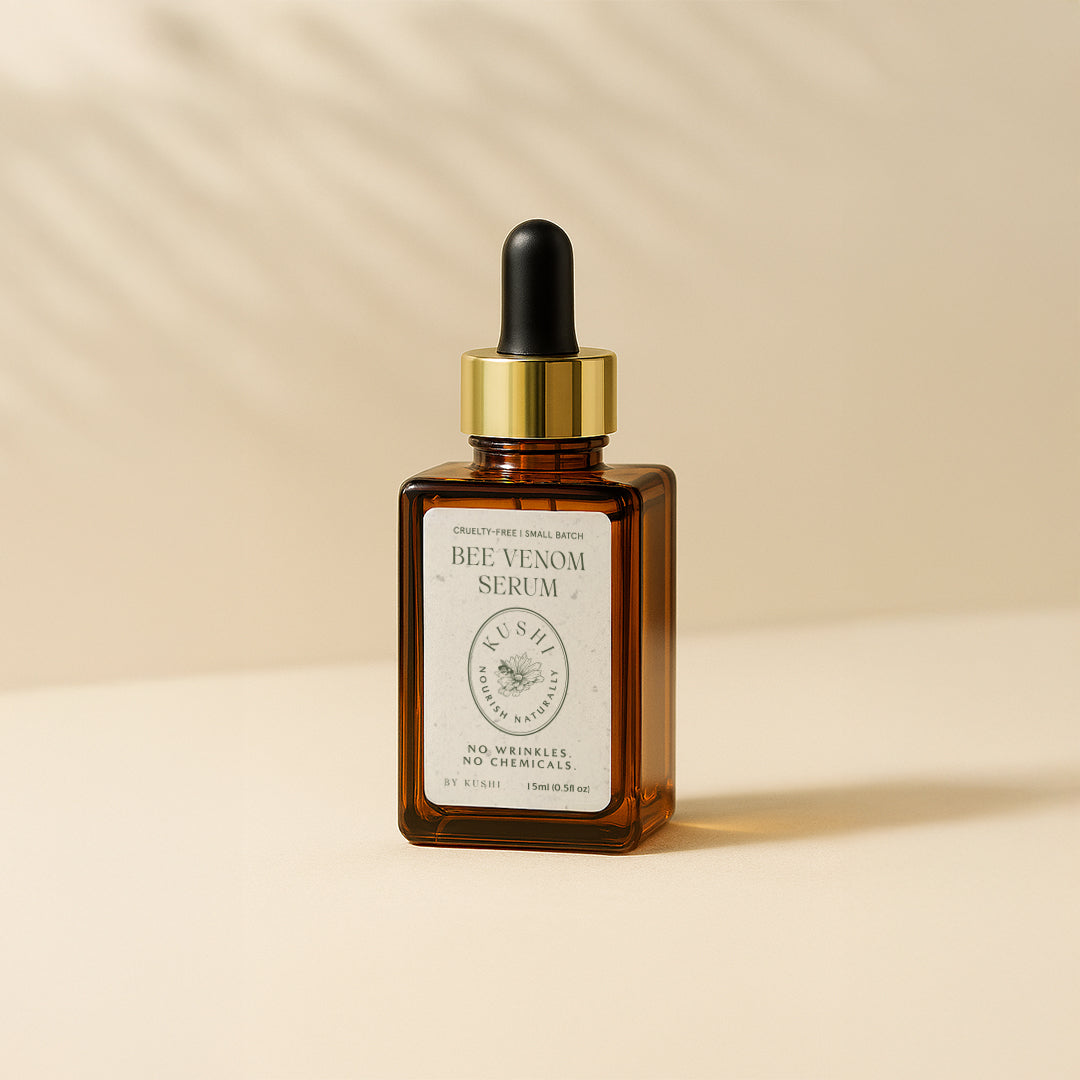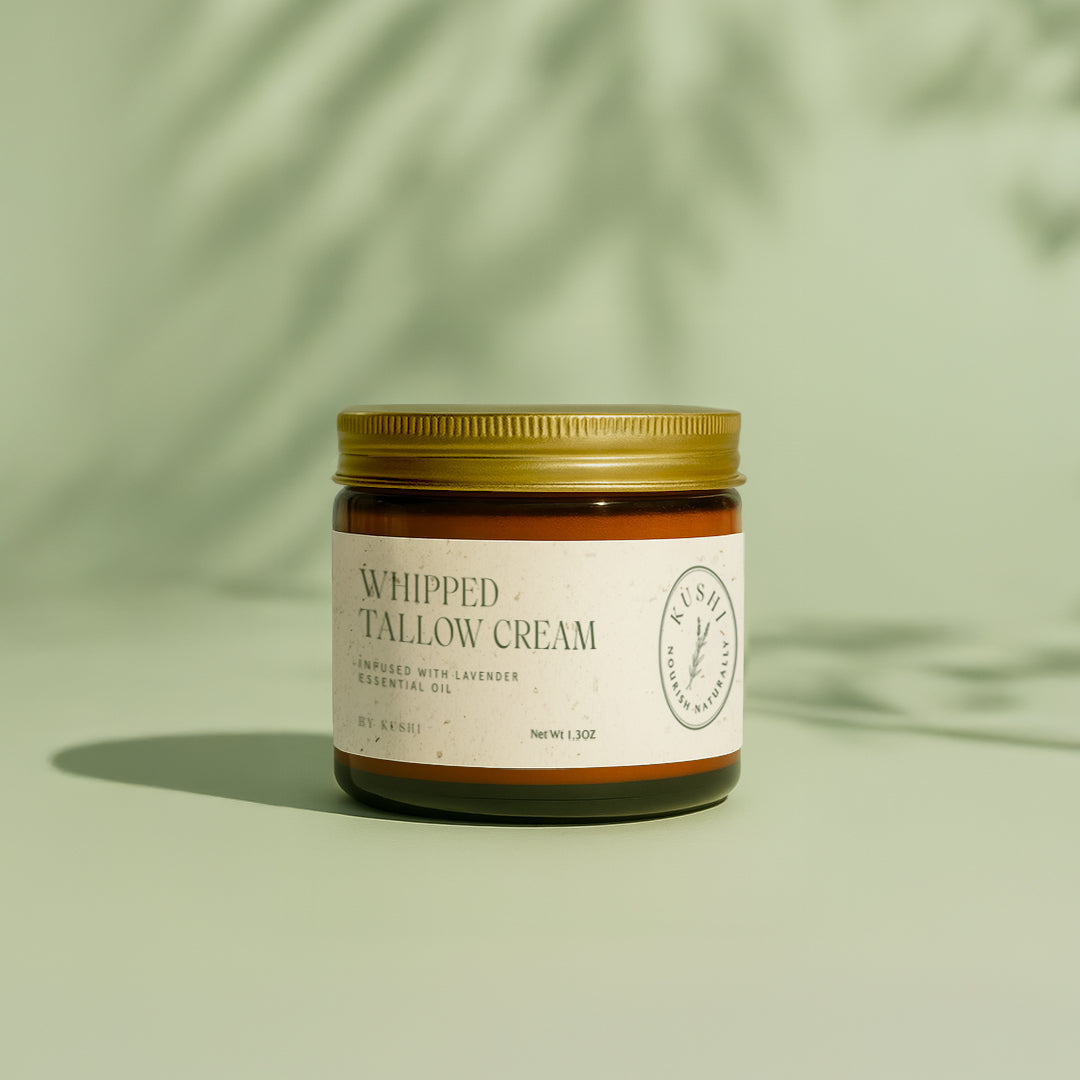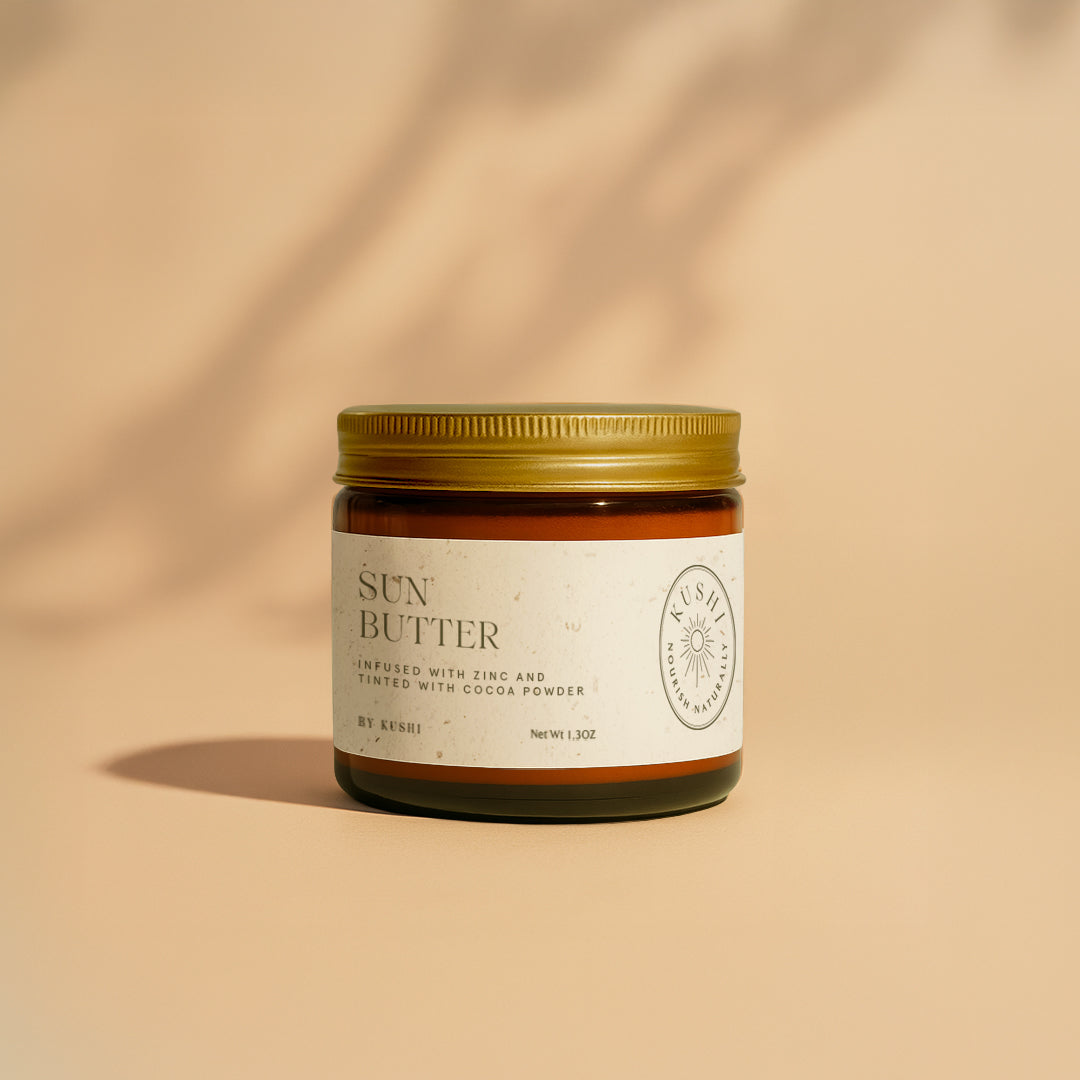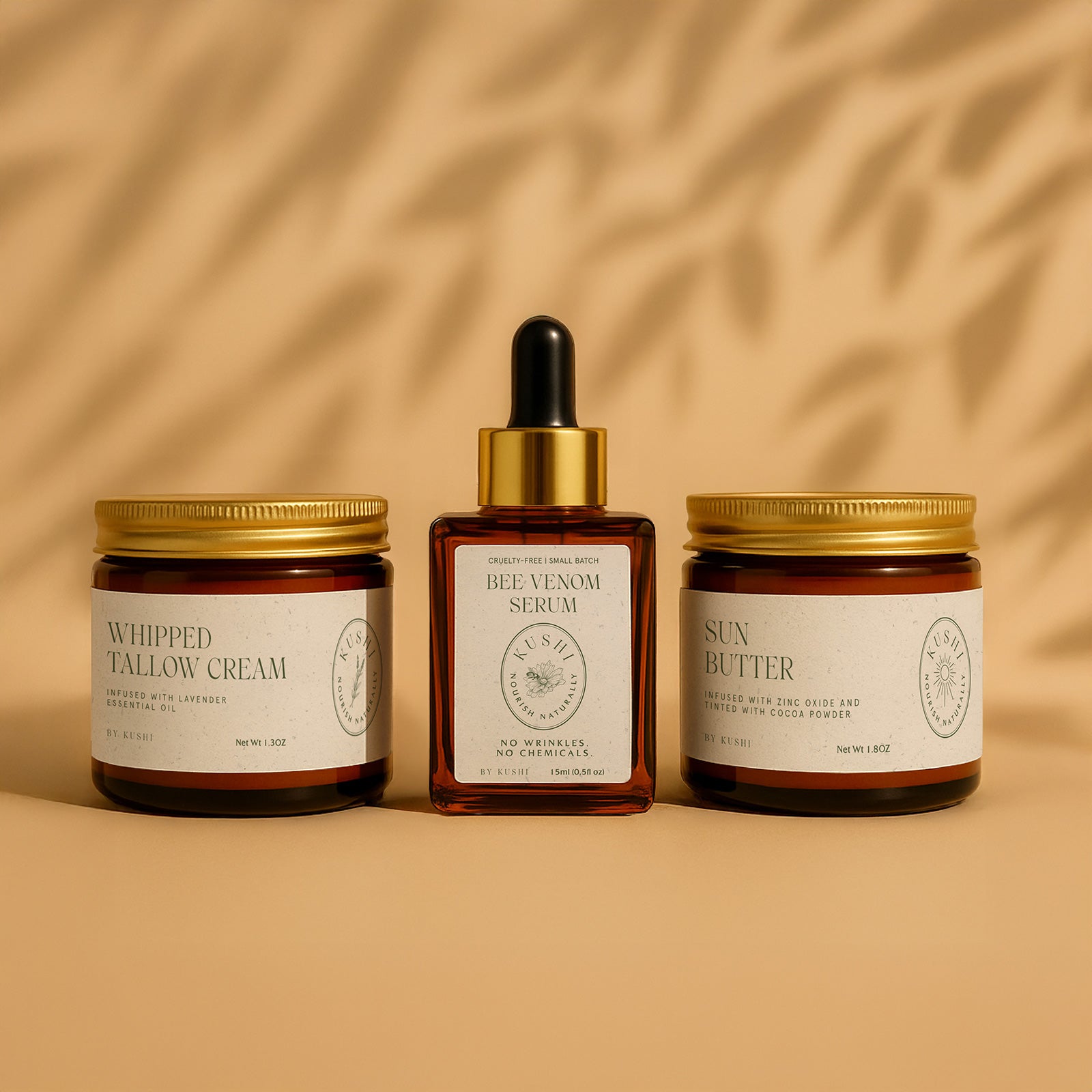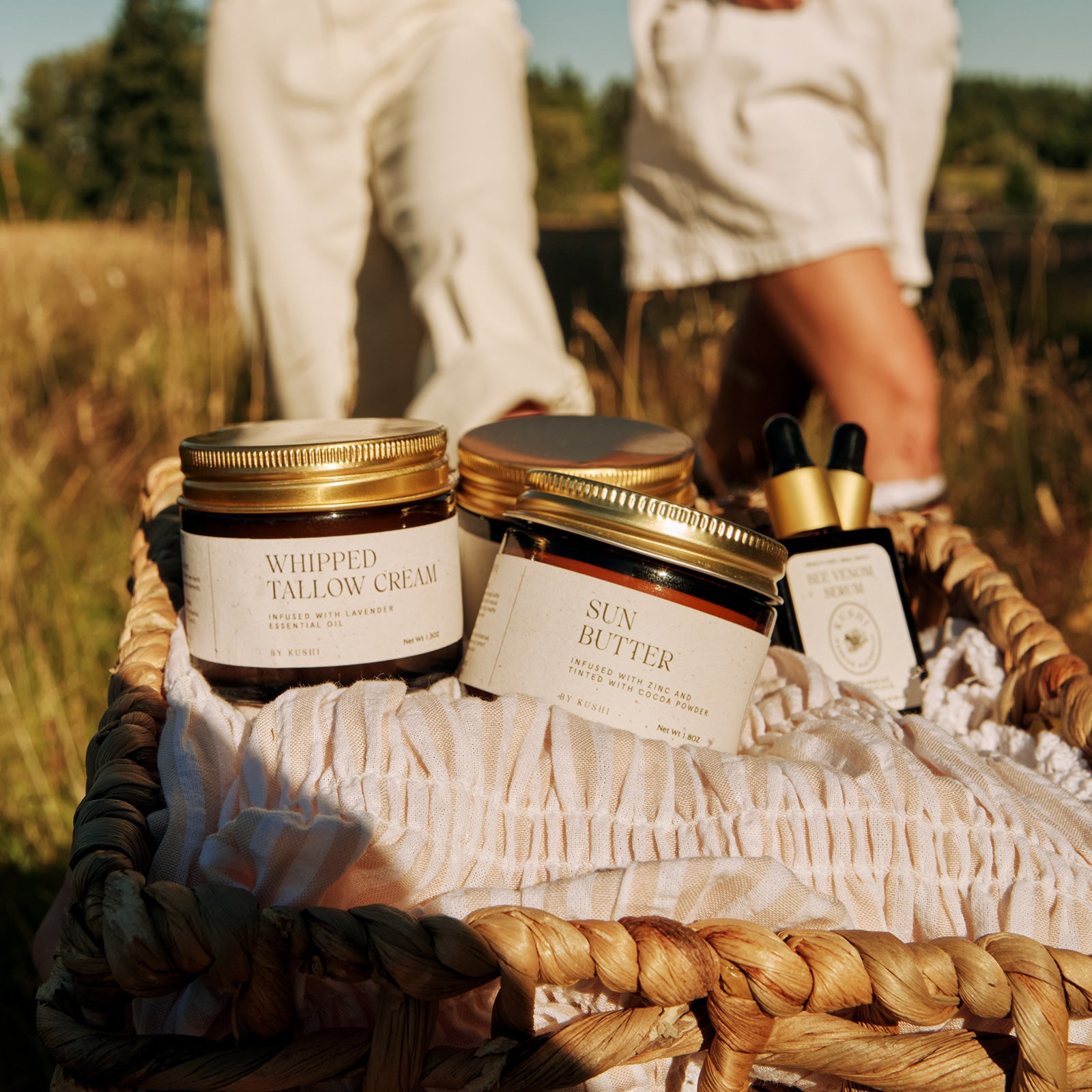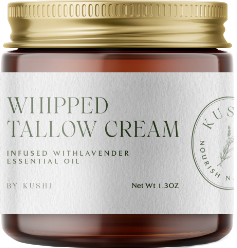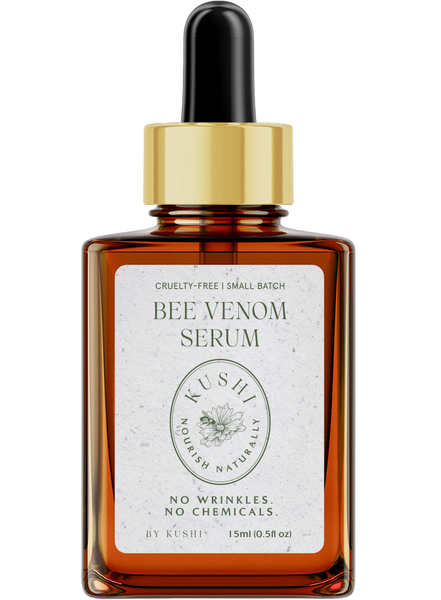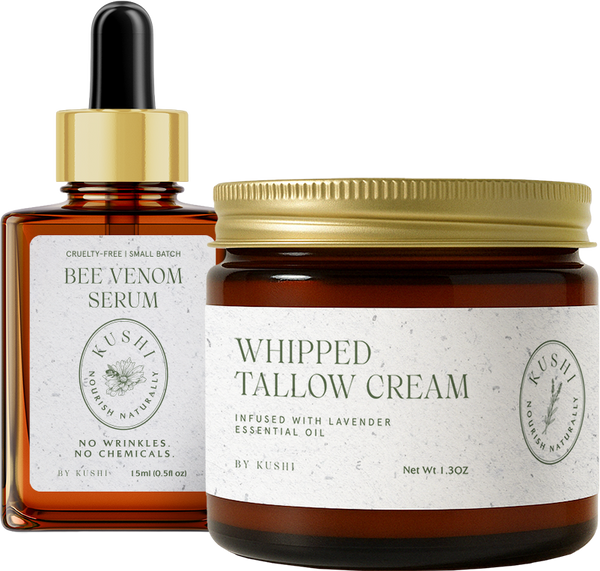Key Takeaways:
-
Skin Compatibility: Mineral sunscreen is gentler on sensitive and acne-prone skin due to its non-absorbing, anti-inflammatory ingredients.
-
Environmental Impact: Chemical sunscreens with filters like oxybenzone can harm marine life, while mineral formulas are generally reef-safe.
-
Product Highlight: Kushi’s Sun Butter offers a clean, non-nano zinc oxide formula that blends smoothly without leaving a white cast.
Sunscreen is often the most overlooked step in skincare, yet it’s one of the most essential. As awareness around UV damage grows, so does confusion about which type of sunscreen to use. The terms "mineral" and "chemical" get tossed around on product labels, but the differences between the two go far beyond marketing. From how they interact with your skin to their potential environmental impact, choosing the right formula can significantly affect both your skin health and your long-term beauty philosophy.
At Kushi, we don’t just formulate skincare, we craft protective rituals rooted in purity, science, and intention. Our mineral-based Sun Butter isn’t the result of trend-chasing; it’s the product of a deep commitment to clean ingredients, skin health, and sustainable beauty. We’ve earned the trust of those who are ingredient-conscious not because we cut corners, but because we never do.
In this piece, we’ll be breaking down mineral vs chemical sunscreen, how each one works, which is better suited for your skin type, and why our own Sun Butter is formulated the way it is.
What’s The Difference Between Mineral And Chemical Sunscreen?
Understanding the difference between mineral and chemical sunscreens is essential for making the right choice for your skin. While both are designed to protect against UV damage, they go about it in very different ways:
Mineral Sunscreen: A Physical Barrier
Mineral sunscreen works by creating a barrier on the surface of your skin. It reflects UVA and UVB rays like a mirror, preventing them from entering the skin at all. This type is often ideal for those with sensitive or reactive skin due to its gentle, non-absorbing formula.
Chemical Sunscreen: UV Absorption Technology
Chemical sunscreens absorb into the top layers of your skin, where they convert UV rays into heat and release it. These formulas tend to be lighter in texture and more water- and sweat-resistant, making them popular for daily wear or outdoor activity.
Both types of sunscreen rely on specific active ingredients. Mineral sunscreens typically contain zinc oxide and/or titanium dioxide, which are naturally occurring minerals. Chemical sunscreens use ingredients like avobenzone, oxybenzone, octinoxate, and octocrylene, which are synthetic compounds that absorb UV rays at a molecular level.
How Each Sunscreen Type Works On Your Skin
Choosing the right sunscreen often comes down to how it interacts with your skin during and after application. Here's what to expect from both mineral and chemical sunscreens in terms of feel, finish, and overall performance:
Mineral Sunscreen: Sits On Top, Starts Protecting Instantly
Because mineral sunscreen doesn’t absorb into the skin, it starts working as soon as it’s applied. It forms a protective barrier on the surface, making it a go-to for those with sensitive or acne-prone skin. However, it can sometimes leave a white cast, especially on deeper skin tones, depending on the formula and particle size.
Chemical Sunscreen: Absorbs Into The Skin Before Activating
Chemical sunscreens need about 15–20 minutes to absorb and begin working. Once absorbed, they’re virtually invisible and often preferred for daily wear under makeup due to their lightweight texture. But because they penetrate the skin, some people with sensitive skin may experience irritation or breakouts, especially with certain filters like oxybenzone.
Ingredients To Know In Mineral Vs Chemical Sunscreens
The effectiveness and skin compatibility of a sunscreen often come down to its active ingredients. Knowing what’s inside can help you choose a formula that aligns with your skin type and personal preferences:
Common Ingredients In Mineral Sunscreens
Mineral sunscreens use zinc oxide and titanium dioxide as their active ingredients. Both are naturally occurring minerals that provide broad-spectrum protection against UVA and UVB rays. Zinc oxide, in particular, is also known for its soothing, anti-inflammatory properties, making it a favorite for sensitive or breakout-prone skin.
Common Ingredients In Chemical Sunscreens
Chemical sunscreens rely on synthetic compounds such as avobenzone, octinoxate, oxybenzone, and octocrylene. These ingredients absorb UV radiation and convert it into heat. While they allow for lightweight, invisible formulas, some of these filters, like oxybenzone, have raised concerns due to potential skin sensitivity and environmental impact.
Pros And Cons Of Mineral Sunscreen
Mineral sunscreens are often chosen for their gentle, non-irritating formulas and natural ingredients. But like any skincare product, they have their strengths and limitations:
Pros
Mineral sunscreens are ideal for sensitive or acne-prone skin, as they use zinc oxide or titanium dioxide, both known for their soothing and non-comedogenic properties. They offer immediate protection upon application and are generally considered reef-safe. Zinc oxide also has mild anti-inflammatory benefits, which can help calm redness or irritation.
Cons
One common drawback of mineral sunscreens is the white cast they can leave, especially on medium to deeper skin tones. The texture may also feel heavier or more difficult to blend compared to chemical options. Some formulas may need more frequent reapplication during intense outdoor activity or water exposure.
Looking for a mineral sunscreen that avoids the typical downsides? Kushi’s Sun Butter delivers smooth, blendable coverage using non-nano zinc oxide and skin-loving botanicals, without synthetic fillers or harsh chemicals.
Which Sunscreen Is Better For Sensitive Skin?
If your skin is prone to redness, breakouts, or irritation, the type of sunscreen you use can make a noticeable difference. The ingredients and how the formula interacts with your skin barrier are key factors to consider.
Mineral Sunscreen For Sensitive Skin
Mineral sunscreens are generally the safest option for sensitive skin. They sit on the skin’s surface rather than being absorbed, which reduces the risk of irritation or clogged pores. Zinc oxide, in particular, has calming properties that can help soothe redness and inflammation.
Chemical Sunscreen For Sensitive Skin
While some people with sensitive skin can tolerate certain chemical sunscreens, many experience stinging, burning, or breakouts, especially around the eyes or on compromised skin. The absorption of synthetic UV filters into the skin can sometimes trigger allergic reactions or inflammation. For this reason, dermatologists often recommend avoiding chemical formulas if your skin is easily irritated.
If sensitivity is a concern, we recommend trying Kushi’s Sun Butter, a gentle mineral sunscreen designed to nourish and protect without overwhelming reactive skin.
Environmental Impact: Mineral vs Chemical Sunscreen
Beyond skin health, sunscreen choice also affects the environment, especially marine ecosystems. The ingredients in your SPF can either help preserve or harm delicate coral reefs and ocean life.
Mineral Sunscreen And The Environment
Mineral sunscreens that use non-nano zinc oxide or titanium dioxide are considered reef-safe. These ingredients don’t dissolve into water or disrupt marine life in the same way some chemical filters do. Because they’re naturally derived and biodegradable, mineral sunscreens are a more sustainable option for both your skin and the planet.
Chemical Sunscreen And Reef Safety Concerns
Ingredients like oxybenzone and octinoxate, found in many chemical sunscreens, have been shown to contribute to coral bleaching and may disrupt marine ecosystems. Some regions, including Hawaii and parts of the Caribbean, have banned sunscreens containing these filters. While not all chemical sunscreens are harmful, it can be difficult to find formulas that are both effective and environmentally conscious.
Want a reef-safe option that doesn’t compromise on performance? Kushi’s Sun Butter is formulated without marine-harming chemicals, making it a responsible choice for beach days and everyday wear.
Why We Love Mineral Sunscreen Especially Kushi’s Sun Butter
With all the benefits mineral sunscreens offer, from skin compatibility to environmental safety, it’s easy to see why they’re becoming a go-to choice for many. But not all mineral formulas are created equal.
Kushi’s Sun Butter stands out because it solves the common frustrations that come with mineral sunscreens. It blends in effortlessly without a white cast, thanks to non-nano zinc oxide and a nourishing base of plant oils and butters. The texture is creamy, lightweight, and suitable for all skin types, including sensitive, acne-prone, and mature skin.
It’s also completely reef-safe, fragrance-free, and free of synthetic preservatives, making it a clean beauty staple that protects your skin and the planet. Whether you're headed to the beach or just walking around the city, Kushi’s Sun Butter offers everyday protection you can feel good about.
Final Thoughts
Both mineral and chemical sunscreens offer effective UV protection, but the right choice depends on your skin type, lifestyle, and personal values. If you prioritize gentle ingredients, instant protection, and reef-safe formulations, mineral sunscreen is the clear winner.
For those seeking a mineral option that doesn’t compromise on texture or wearability, Kushi’s Sun Butter is a standout. It’s thoughtfully formulated for daily use, providing broad-spectrum protection while supporting healthy, balanced skin.
No matter what you choose, the most important step is consistency. Wearing sunscreen every day is one of the simplest ways to protect your skin, now and long into the future.
Read Also:
Frequently Asked Questions About Mineral Vs Chemical Sunscreen
Is mineral sunscreen better for kids than chemical sunscreen?
Yes, mineral sunscreens are typically recommended for children because they’re less likely to cause irritation and are free of synthetic UV filters that can be absorbed into the skin.
Can I use both mineral and chemical sunscreens together?
Technically yes, but combining them may dilute the effects of one or both. It’s best to choose one type and reapply it consistently for optimal protection.
Does mineral sunscreen expire faster than chemical sunscreen?
Not necessarily. Both types usually have a shelf life of about three years, but exposure to heat and sunlight can degrade them faster, especially natural formulas without preservatives.
Is chemical sunscreen safe to use during pregnancy?
Some chemical filters, like oxybenzone, are not recommended during pregnancy due to potential hormonal disruption. Mineral sunscreens are a safer alternative for expecting mothers.
Do mineral sunscreens clog pores?
Most mineral sunscreens are non-comedogenic, meaning they won’t clog pores. Zinc oxide is also known for helping calm acne-prone skin.
Can chemical sunscreen stain clothes?
Yes, some chemical sunscreens can leave yellowish stains on white clothing, especially around collars or straps. Mineral sunscreens are less likely to cause this issue.
Sources:
- Matta, M. K., Zusterzeel, R., Pilli, N. R., Patel, V., Volpe, D. A., Florian, J., Oh, L., Bashaw, E., Zineh, I., Sanabria, C., Kemp, S., Godfrey, A., Adah, S., Coelho, S., Wang, J., Furlong, L. A., Ganley, C., Michele, T., & Strauss, D. G. (2019). Effect of sunscreen application under maximal use conditions on plasma concentration of sunscreen active ingredients: A randomized clinical trial. JAMA, 321(21), 2082‑2091. https://doi.org/10.1001/jama.2019.5586
- Downs, C. A., Kramarsky‑Winter, E., Segal, R., Fauth, J., Knutson, V., Bronstein, O., Ciner, E., & Lichtenfeld, Y. (2016). Toxicopathological effects of the sunscreen UV filter, oxybenzone (benzophenone‑3), on coral planulae and cultured primary cells and its environmental contamination in Hawaii and the US Virgin Islands. Archives of Environmental Contamination and Toxicology, 70(2), 265‑288. https://doi.org/10.1007/s00244-015-0227-7
- Thomas, T., Fat, M., & Kearns, G. (2024). Sunscreens: potential hazards to environmental and human health. Frontiers in Marine Science, 11, Article 1471574. https://doi.org/10.3389/fmars.2024.1471574
- Dinardo, J. C., & Downs, C. A. (2018). Dermatological and environmental toxicological impact of the sunscreen ingredient oxybenzone/benzophenone‑3. Journal of Cosmetic Dermatology, 17(1), 15‑19. https://doi.org/10.1111/jocd.12449
